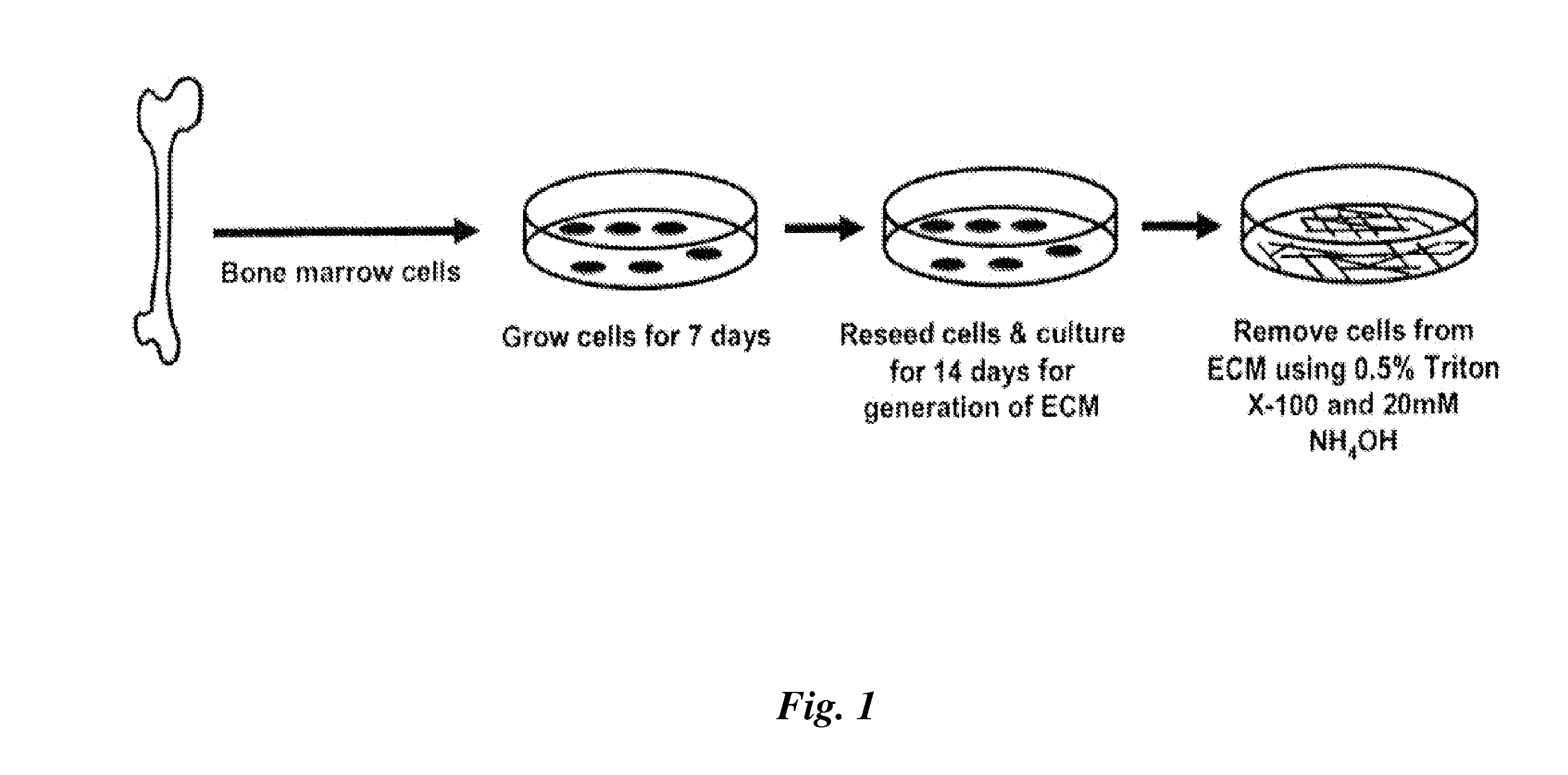Maintenance and Propagation of Mesenchymal Stem Cells
- Summary
- Abstract
- Description
- Claims
- Application Information
AI Technical Summary
Benefits of technology
Problems solved by technology
Method used
Image
Examples
example 1
[0079]FIG. 1 illustrates an exemplary method for manufacturing a cell culture apparatus for maintaining or propagating MSCs in culture in an undifferentiated state.
[0080]Freshly isolated murine femoral marrow cells were seeded onto tissue culture plastic at 3×105 cells / cm2, and cultured for seven days in α-MEM (Life Technologies, Grand Island, N.Y.), supplemented with glutamine (2 mM), penicillin (100 U / ml), streptomycin (100 μg / ml) (Sigma Chemical Company, St. Louis, Mo.), and 15% pre-selected fetal bovine serum (FBS, Atlanta Biologicals, Lawrenceville, Ga.). For preparation of skin fibroblasts, the ventral skin from 2-5 day old mice were removed, rinsed in PBS, and cut into 1-mm2 pieces. The tissue was incubated with 400 U / ml collagenase for 40 minutes at 37° C., rinsed with PBS, and cultured in high glucose DMEM medium containing 10% FBS, glutamine (2 mM) and penicillin (100 U / ml) until primary fibroblasts migrated out of the samples onto the culture plates reaching 70% confluenc...
example 2
[0082]Preparation of a marrow stromal cell-derived ECM. Scanning electron microscopy (SEM) revealed that stromal cells cultured from murine femoral bone marrow elaborated a fibrillar ECM (FIG. 2A). Prior to studying the behavior of MSCs on this ECM, the stromal cells were lysed with 0.5% Triton X-100 containing 20 mM NH4OH followed by DNase treatment to digest remaining nuclear contaminants.(20) The resulting 3D matrix contained fibers of approximately 25 nm diameter and was approximately 100 μm thick as determined by transmission electron microscopy (data not shown).
[0083]When examined prior to removal of stromal cells, immunostaining revealed high levels of collagen types I, III, V, syndecan-1, perlecan, fibronectin, laminin, biglycan and decorin associated with both stromal cells and the ECM (FIG. 2B). The protein composition of the ECM was only modestly affected by the cell extraction procedure as indicated by retention of immunostaining for all of the proteins that were examine...
example 3
[0084]Culture on stromal cell-derived ECM facilitates retention of MSC properties. The ECM affects MSC adherence and proliferation. MSCs were detected and quantified by their ability to form a colony of fibroblastic cells.(21) These colony-forming cells, called colony forming unit-fibroblasts (CFU-F), comprise MSCs. After five days of culture, most of the cells in the colony were embedded inside of the collagenous matrix and exhibited a fibroblastic morphology with extensive cellular processes. In contrast, cells cultured on tissue culture plastic were round and flat (FIG. 3A).
[0085]When cultured on the stromal cell-derived ECM, there was approximately a two to three fold increase in the number of CFU-F as compared to tissue culture plastic, demonstrating that the ECM promoted MSC attachment (FIGS. 3B and 3C). 2D ECM preparations, made by coating tissue culture plasticware with fibronectin or Type I collagen, were less effective (FIGS. 3B and 3C). Moreover, the colonies that develop...
PUM
 Login to View More
Login to View More Abstract
Description
Claims
Application Information
 Login to View More
Login to View More - R&D
- Intellectual Property
- Life Sciences
- Materials
- Tech Scout
- Unparalleled Data Quality
- Higher Quality Content
- 60% Fewer Hallucinations
Browse by: Latest US Patents, China's latest patents, Technical Efficacy Thesaurus, Application Domain, Technology Topic, Popular Technical Reports.
© 2025 PatSnap. All rights reserved.Legal|Privacy policy|Modern Slavery Act Transparency Statement|Sitemap|About US| Contact US: help@patsnap.com



